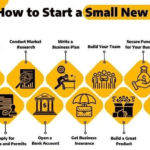10 Common Reasons Startups Fail (And How to Avoid Them)
Starting a business is exciting, but statistics show that 90% of startups fail, with 10% closing within the first year. While the reasons vary, many failures stem from avoidable mistakes. If you’re launching a startup, understanding these common pitfalls can help you build a stronger, more resilient business.
In this post, we’ll explore 10 common reasons startups fail and provide actionable strategies to avoid them.
1. Lack of Market Demand
📉 The Problem:
Many startups create products or services without validating demand. If there’s no real need for what you’re offering, your business won’t survive.
✅ How to Avoid It:
✔ Conduct market research before launching.
✔ Talk to potential customers and gather feedback.
✔ Use MVP (Minimum Viable Product) testing to see if people are willing to pay.
💡 Example: Dropbox validated demand by creating a simple explainer video before developing the product. This saved time and money while proving market interest.
2. Running Out of Money
📉 The Problem:
Startups often overspend on unnecessary expenses (offices, hiring, advertising) before becoming profitable. Without proper financial management, businesses quickly burn through cash.
✅ How to Avoid It:
✔ Keep overhead costs low in the early stages.
✔ Focus on revenue-generating activities first.
✔ Secure funding options (bootstrapping, investors, crowdfunding).
💡 Example: Airbnb started by renting air mattresses in their apartment, proving their concept before raising millions in funding.
3. Poor Business Model
📉 The Problem:
A business model that doesn’t generate consistent revenue will struggle to survive. Some startups focus on growth without profitability, leading to financial failure.
✅ How to Avoid It:
✔ Define a clear revenue model from the start.
✔ Test different pricing strategies to maximize profit.
✔ Ensure costs don’t exceed revenue as you scale.
💡 Example: Amazon started with books only, proving its revenue model before expanding into other categories.
4. Weak Marketing Strategy
📉 The Problem:
Even great products fail without effective marketing. Many startups rely solely on word-of-mouth or expect customers to find them without an outreach plan.
✅ How to Avoid It:
✔ Identify your target audience and where they spend time.
✔ Use low-cost marketing strategies (social media, SEO, content marketing).
✔ Focus on customer acquisition & retention.
💡 Example: Dollar Shave Club went viral with a low-budget, humorous marketing video, generating millions in sales.
5. Bad Team & Leadership Issues
📉 The Problem:
A startup is only as strong as its team. Many fail due to poor leadership, lack of experience, or co-founder conflicts.
✅ How to Avoid It:
✔ Choose co-founders with complementary skills.
✔ Ensure strong communication and teamwork.
✔ Hire slowly—the right people make all the difference.
💡 Example: Google’s success came from strong leadership and teamwork between Larry Page, Sergey Brin, and Eric Schmidt.
6. Pricing Issues
📉 The Problem:
Startups either overprice (losing customers) or underprice (losing profit). Poor pricing strategies can destroy even the best businesses.
✅ How to Avoid It:
✔ Research competitor pricing and customer expectations.
✔ Test different pricing models (subscription, freemium, tiered pricing).
✔ Offer value-based pricing instead of racing to the lowest price.
💡 Example: Apple’s premium pricing works because it delivers high perceived value with quality branding.
7. Ignoring Customer Needs
📉 The Problem:
Startups sometimes assume they know what customers want instead of actively listening. This leads to products/services that don’t solve real problems.
✅ How to Avoid It:
✔ Collect customer feedback regularly.
✔ Adapt and improve based on customer input.
✔ Offer excellent customer service to build loyalty.
💡 Example: Netflix switched from DVD rentals to streaming after listening to customer preferences.
8. Not Adapting to Market Changes
📉 The Problem:
Markets evolve, and startups that fail to adapt lose relevance. Sticking to an outdated business model can lead to failure.
✅ How to Avoid It:
✔ Stay informed on industry trends and competitors.
✔ Be flexible—pivot if needed.
✔ Innovate before the market forces you to.
💡 Example: Instagram started as a check-in app (Burbn) before pivoting to a photo-sharing platform based on user behavior.
9. Poor Product Execution
📉 The Problem:
A great idea alone isn’t enough. Many startups fail due to bad product design, poor user experience, or unreliable performance.
✅ How to Avoid It:
✔ Prioritize quality and user experience.
✔ Test with a small group before full launch.
✔ Keep improving based on user feedback.
💡 Example: Tesla continuously updates its software and features based on user feedback, keeping customers engaged.
10. Legal & Compliance Issues
📉 The Problem:
Ignoring legal requirements (business registration, tax laws, intellectual property) can cause lawsuits or shutdowns.
✅ How to Avoid It:
✔ Register your business properly.
✔ Get trademarks, patents, and contracts to protect your brand.
✔ Follow tax and employment laws in your country.
💡 Example: Facebook faced multiple legal battles over privacy policies, proving the importance of legal compliance.
Final Thoughts: How to Build a Startup That Succeeds
Starting a business is challenging, but avoiding these mistakes increases your chances of success.




